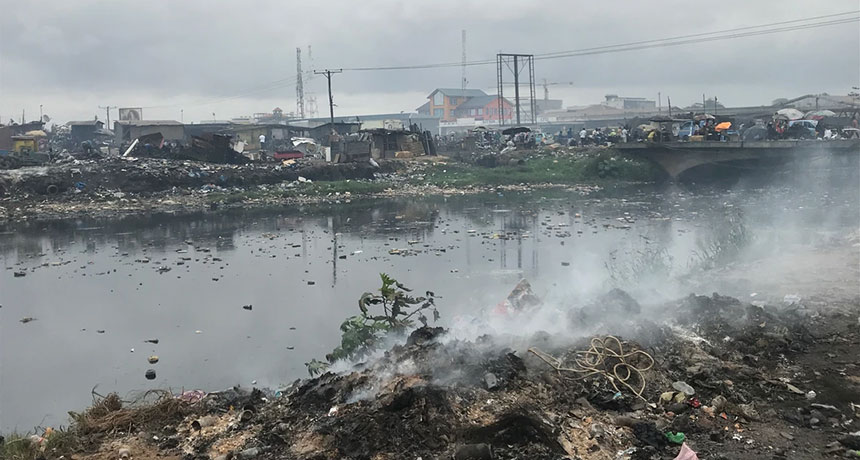Antibiotics pollute many of the world’s rivers
The new findings suggest a growing risk that drug-resistant germs will develop throughout the environment

A new survey finds antibiotics in about two-thirds of 711 river sites tested. They include the Odaw River, shown, running through Ghana’s capital of Accra.
Rob Marchant
Antibiotics taint two out of every three rivers sampled as part of a big new survey. Scientists made the finding while testing water from 165 rivers across 72 countries. Many of most polluted sites were in Asia and Africa. Until now, there had been little testing in these areas for drugs in water.
The new data are a big concern. Bacteria that can’t be killed by antibiotics pose a large and growing threat to health. Doctors call these bacteria “superbugs.” As microbes encounter drugs in the environment, many will evolve changes. Called mutations, some of these may allow the germs to survive the drugs. Later, people infected with those microbes may find themselves at risk of life-threatening disease.
It doesn’t matter that some of these pollution problems are occurring in far-off sites around the world. People should still be as concerned about resistance evolving in these places as they are about it developing in their own backyards, says William Gaze. He’s a microbial ecologist in England who works at the University of Exeter Medical School. Even if wealthy countries wipe out antibiotic pollution, drug-resistant microbes can hitch a ride to those countries. They can arrive with sick travelers. They might move around the world in migrating birds. They might even arrive in imports of animal-based foods, says Gaze. “It’s a global problem,” says this scientist, who was not involved with the new survey. That’s why, he adds, “We need global solutions.”
Alistair Boxall and John Wilkinson work in England at the University of York. Together, they tested water from 711 sites. And 470 of them contained at least one antibiotic.
About one in every seven of the sites tested — 111 in all — contained unsafe levels of the drugs. That judgment is based on guidelines by the AMR Industry Alliance. It’s a global group of biotech and drug companies. It has set safety thresholds. And those are based on data showing what levels of a drug would neither kill algae nor promote drug resistance in bacteria.
“I don’t think I was expecting the degree of [high] concentrations that we saw,” says Boxall, who is an environmental chemist. “That was quite eye-opening.”
He and Wilkinson shared their findings in a pair of papers presented on May 27 and May 28. They spoke in Helsinki, Finland at a meeting of the Society of Environmental Toxicology and Chemistry.
More wide-ranging survey than ever before
No survey of drugs in water has ever been carried out on this scale, Boxall says. Earlier ones had focused on rivers in North America, Europe and China. In contrast, he and Wilkinson sent water-collection kits to colleagues all over the world. Then they tested the water they got back for 61 drugs. These included the 14 antibiotics.
Samples continue to roll in and the researchers plan to release more data in the future. “Ultimately, it would be nice if we could get samples from every country of the world,” Boxall says.
Many sites with unsafe levels of the drugs contained more than one antibiotic. The most commonly found one was trimethoprim (Try-METH-oh-prim). It’s used to treat urinary-tract infections. And it showed up at more than four out of every 10 sites sampled. Other commonly found antibiotics were sulfamethoxazole (Sul-fa-meh-THOX-uh-zole), ciprofloxacin (Cih-pro-FLOX-uh-sin) and metronidazole (Meh-troh-NY-duh-zole).
The Kirtankhola River, near the south-central city of Barisal, Bangladesh, contained the highest antibiotic level of any site. Metronidazole levels there approached 40,000 nanograms per liter. That’s roughly 300 times what is considered safe. And the level of ciprofloxacin there was eight times what is deemed safe.
High antibiotic levels also showed up in several African rivers. These included ones in Accra, the capital of Ghana; near Kenya’s capital city of Nairobi; and near Lagos, Nigeria’s biggest city. High levels also showed up in Lahore, the second-most populated city in Pakistan, and in a river near the Israeli city Nablus.
The highest level of antibiotics in Europe turned up in an urban tributary of the Danube as this river travels through Austria. The most polluted U.S. river was in North Liberty, Iowa, near many livestock farms.
The researchers did some detective work to figure out how the drugs were getting into these water. Google Street View showed some tainted waters were near plants that make medicines. Perhaps they released drug-making wastes into local waters, the researchers say. Photos from several very polluted sites in Africa and Asia, Boxall notes, also showed trash heaped along riverbanks and sewage-carrying trucks.
How deep a river is, how fast it flows and whether a sampling site was downstream of a city or hospital can also affect levels of any drugs found, Boxall says.
He, Wilkinson and their colleagues plan to test how levels of the drugs measured at some sites might affect algae and other organisms. They hope such findings can help officials across the globe take needed action to cut drug pollution.







